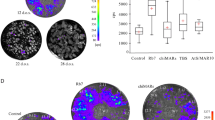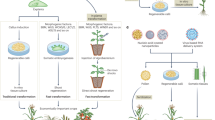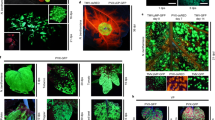Abstract
Quist and Chapela1 claim that transgenic DNA constructs have been introgressed into a traditional maize variety in Mexico, and furthermore suggest that these constructs have been reassorted and introduced into different genomic backgrounds. However, we show here that their evidence for such introgression is based on the artefactual results of a flawed assay; in addition, the authors misinterpret a key reference2 to explain their results, concluding that reassortment of integrated transgenic DNA occurs during transformation or recombination.
This is a preview of subscription content, access via your institution
Access options
Subscribe to this journal
Receive 51 print issues and online access
$199.00 per year
only $3.90 per issue
Buy this article
- Purchase on Springer Link
- Instant access to full article PDF
Prices may be subject to local taxes which are calculated during checkout

Similar content being viewed by others
Notes
Editorial note
In our 29 November issue, we published the paper “Transgenic DNA introgressed into traditional maize landraces in Oaxaca, Mexico” by David Quist and Ignacio Chapela. Subsequently, we received several criticisms of the paper, to which we obtained responses from the authors and consulted referees over the exchanges. In the meantime, the authors agreed to obtain further data, on a timetable agreed with us, that might prove beyond reasonable doubt that transgenes have indeed become integrated into the maize genome. The authors have now obtained some additional data, but there is disagreement between them and a referee as to whether these results significantly bolster their argument.
In light of these discussions and the diverse advice received, Nature has concluded that the evidence available is not sufficient to justify the publication of the original paper. As the authors nevertheless wish to stand by the available evidence for their conclusions, we feel it best simply to make these circumstances clear, to publish the criticisms, the authors' response and new data, and to allow our readers to judge the science for themselves.
Editor, Nature
References
Quist, D. & Chapela, I. H. Nature 414, 541–543 (2001).
Pawlowski, W. & Somers, D. A. Proc. Natl Acad. Sci. USA 95, 12106–12110 (1998).
Neto, R. B. Nature 402, 344 (1999).
Jayaraman, K. S. Nature 413, 555 (2001).
Author information
Authors and Affiliations
Corresponding author
Ethics declarations
Competing interests
Matthew Metz has a consulting
position (roughly 5 hours per week) with Tilligen Inc., Seattle,
Washington. Tilligen is developing an alternative technology to
transgenic crops, and could lose financial
advantage as a result of the submitted critique.
Rights and permissions
About this article
Cite this article
Metz, M., Fütterer, J. Suspect evidence of transgenic contamination (see editorial footnote). Nature 416, 600–601 (2002). https://doi.org/10.1038/nature738
Published:
Issue Date:
DOI: https://doi.org/10.1038/nature738
This article is cited by
-
Challenges for transgene detection in landraces and wild relatives: learning from 15 years of debate over GM maize in Mexico
Biodiversity and Conservation (2018)
-
Dual invasion analysis: a general model of novel ecological dynamics due to Bt product and resistant pests in wild settings
Theoretical Ecology (2014)
-
Case studies: A hard look at GM crops
Nature (2013)
-
Modified genes spread to local maize
Nature (2008)
-
Traditional Mexican Agricultural Systems and the Potential Impacts of Transgenic Varieties on Maize Diversity
Agriculture and Human Values (2006)
Comments
By submitting a comment you agree to abide by our Terms and Community Guidelines. If you find something abusive or that does not comply with our terms or guidelines please flag it as inappropriate.



